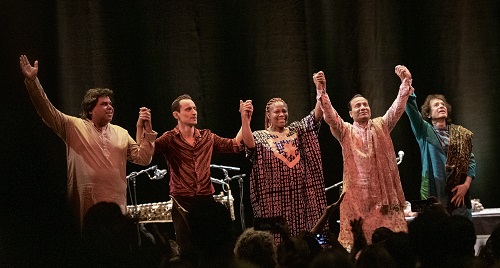 United States Zakir Hussain’s Masters of Percussion: Zakir Hussain (tabla), Sabir Khan (sārangī, vocals), Tupac Mantilla (percussion), Melissa Hié (djembe, vocals, balafon), Navin Sharma (dholak). Cal Performances, Zellerbach Hall, University of California, Berkeley, 11.3.2023. (HS)
United States Zakir Hussain’s Masters of Percussion: Zakir Hussain (tabla), Sabir Khan (sārangī, vocals), Tupac Mantilla (percussion), Melissa Hié (djembe, vocals, balafon), Navin Sharma (dholak). Cal Performances, Zellerbach Hall, University of California, Berkeley, 11.3.2023. (HS)

Zakir Hussain may be the master of tabla, the array of small drums from India that create the many-pitched percussion sounds of ragas and other music from Asian subcontinent, but he is also a magnet for percussionists from virtually every other culture in the world that has a beat.
Aside from his appearances in classical Indian music and collaborations with artists in jazz and other genres, his regular tours under the title ‘Masters of Percussion’ bring percussionists from exotic regions together (much like another of his projects, ‘Planet Drum’, which has produced five recordings so far). The visit to the University of California Berkeley on Saturday night delivered a combination of theatricality, musical heart and phenomenal virtuosity. It was over-the-top exciting.
Without any announcements, the concert opened with a solo singer chanting melodiously in an Indian dialect from offstage. On the stage, places for five musicians were arrayed across four raised platforms, microphones pointed at their instruments. One by one, the musicians took their places as the chanting continued.
The voice belonged to Sabir Khan, from Rajasthan in northwestern India, who settled into a spot next to Hussain’s gold-tinged tablas. On the left, Colombian percussionist Tupac Mantilla sat among an assortment of drums, cymbals and a gong, arrayed in the manner of a drum kit. Next to him, Navin Sharma wrangled his dholak, a two-headed drum played horizontally, onto his lap. And at the center, Melissa Hié took a seat behind her djembe, a West African drum shaped a bit like a champagne glass.
Hié answered Khan’s chant by singing the opening theme of an African song and, like Khan’s chant, a cry from the heart. She accompanied herself with soft flourishes on the djembe, and Mantilla added accents of jingling and shaking. Hussain finally joined in with a few flourishes on his tabla, and then, in turn, each musician took an extended improvised solo, as if to introduce themselves and their instruments.
First up was Mantilla, who has made quite a reputation as a solo percussionist who can also create music by clapping his hands and slapping his body. He drew out an impressive range of sounds and created infectious rhythms. Even more extraordinary, he could answer the many pitches of Hussain’s tablas just by repeating the musical gestures on his own body.
Next up was Hié, who drew fluency and complex rhythms from the djembe, traditionally an instrument played only by men. She established how fluent the djembe could be in complex rhythms without losing its essentially rough power. Khan responded with a solo on the sārangī, a bowed, short-necked string instrument played in traditional and folk music from Punjab to Rajasthan. It struck me how much its sound calls to mind the cry of a human voice.
Hié, of Burkina Faso heritage, born in France and living in Bordeaux, played with Hussain on the most recent Planet Drum album. She followed with a full version of her song ‘Africa’ (not the hit by Toto), that expanded into a beautifully developed improvisation on the djembe. Later, she set down her drum to play ‘Faso Denou’, a folk-like tune, on the balafon, a gourd-resonated xylophone found across West Africa from Guinea to Mali. Her combination of sincerity, musical deftness and joyful expressiveness was mesmerizing.
Whether he was adding sprinkles of extra spice with flourishes on his drums or taking the spotlight to create technicolor solos, Mantilla acted as a sort of western hemisphere counterpart to Hussain’s jaw-dropping musicality rooted in the East. They both could slip in quick bursts of rhythmic phrases to complete musical phrases of other players, or take off on their own into extensive minutes of high-level improvisations.
On his dholak, Sharma used the pitch difference between the smaller drumhead’s higher, sharper tones and the larger drumhead’s thumping bass to add depth to the rhythms when all the instruments were playing.
Rising over all of them was Hussain. His command of the tabla lets him seem to play with time, even when keeping a steady rhythm, the rests between the notes creating the space to let the flourishes stand out. His duets with each of the other musicians seasoned the unfolding improvisations.
For Hussain, finding common ground with both Khan and Sharma was not surprising. A duet with Khan’s sārangī sashayed amiably until it picked up speed and intensity to reach a triumphant finish (a classic trope in Indian music). Hussain’s ability to fly in formation with Mantilla and Hié was even more rewarding. He fit his Indian phrasing with theirs seamlessly, without losing the flavor of their culture’s rhythms. And they returned the favor.
Not a word had been spoken over the 90 uninterrupted minutes of music, but stories had been told again and again. Whole paragraphs of complex layers of expression had risen to climaxes and relaxed into swaying rhythms before gaining intensity. When the musicians settled into a final improvisation that built on a common rhythm, Hussain got on the microphone to acknowledge their contributions and give the audience a chance to applaud each of them.
The nearly full house responded with cheers as explosive as the music, all well deserved.
Harvey Steiman
Legend are legends … salute to this entire team, and specially designed by Ustad Zakir Hossain ji ki jai ho jata Mata Di 🙏🙏🙏